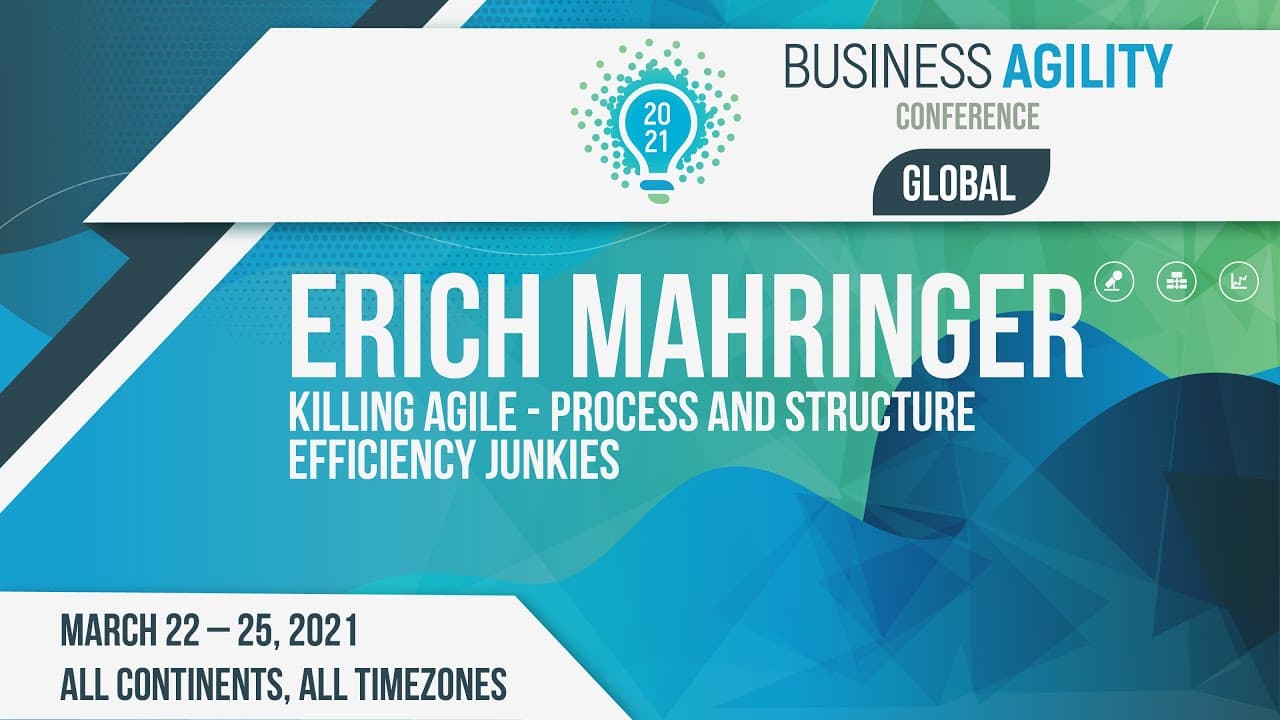Thank you very much for having me. So, yeah, first of all, to start this presentation, I have to admit something, which means that I actually am an efficiency junkie. The things that we want to kill today, or that might kill agile, are also things that I find very deeply within myself. If I look at personal behavior, it’s kind of, as soon as I see a spreadsheet somewhere and I have to ditch the same number twice, I start to automate it. I cannot work around that. If you look into my calendar, it’s pretty well perfectly filled, so every slot is booked. You probably know this yourself. This is also part of high efficiency. I’m probably addicted to it. I can’t stand moments being on-site if I don’t have a meeting with somebody, and I’m always trying to use the time the best I can.
Even my hobby—cycling—is something I do indoors in winter, especially in Austria with the snow. There’s a trend for people to cycle and race online, but I don’t do that because I need to use the time the best I can to do courses, learnings, watching videos, reading books, whatever, on my bike as well. So, honestly, I admit I’m a real efficiency junkie.
But what does it mean? First of all, let me introduce myself. Thanks for Mike having done the quick introduction. Actually, I’m currently working for Smart E-commerce. I did a lot of coaching in the past, and now I’m really back in an executive position, working back in product. I also took this chance to look a bit back into the past and what I took out of the moments being a coach, being somebody who transformed companies, who brought processes into a company, and thinking about what we did there. Did we do something good for the companies? Was it something that might be a learning that maybe in the future I would do differently?
Please be aware, this is just my two cents on what efficiency processes in agile environments mean, and how we can kill agility by focusing maybe on the wrong things.
Efficiency and Lean Concepts
Starting with efficiency, it’s basically something I learned a lot in the last years in the production industry, where lean concepts are big. It’s about reducing waste, meaning any activity that has no value to the end customer has to be eliminated, something that matches with agile principles as well. Another concept is unevenness—if you have days where you do a lot and days where you do nothing, you don’t have real balance in your work, and that brings you out of the flow. Overburdening a team can kill anything creative along the way. So, there are lots of concepts in production, and also in agility and business agility, that interconnect. But we must learn to apply them properly for creative work, especially for product development.
Managing Work
Let me walk through a few ideas I’ve learned. First: managing work. In the organizations I’ve seen, we were especially scrum-ish, highly efficient, and highly engaged in bringing work in and placing people on the right tasks. We had project management, project controlling, project meetings, perfect staffing planning. We tried to use the resources the best we could. In the end, though, the huge amount of time and work we invested in managing is something we must consider in terms of waste. If we think about ourselves—we’re mostly managers—what we do in regards to management is pure waste. So, the question is: is it really a bad thing that we invest so much in distributing tasks and ensuring teams do the right things, or is it better to invest more time in leadership, enabling teams to perform, and letting them manage their own efficiency?
If we look at the management overhead we produce in self-organizing teams, it’s still pure waste, but it’s much lower. On the other hand, the unplanned “waste” time that the teams have can be used in a very efficient way—refactoring, innovative things, research, learning. The idea is that people know best how to invest that unplanned time. So, that’s my suggestion: reduce what we spend on management and shift it more into leadership, letting people learn how to reduce waste themselves as they go.
Process-Driven Companies
The title also includes process industry companies, which are very process-driven. From software businesses to smaller companies, we might see more processes introduced in growth phases. Eventually, we can become supportive with processes, or we can start letting processes become their own goals, overshadowing the outcomes. Some organizations slip into a stable but lower-output mode where processes rule and overshadow the real product or outcome. Then you either focus on improving that or face a downward spiral of people working around or against the process.
Focus vs. Overload
We often have a lot to do, especially in management, with multiple projects and teams. Initially, we can focus well on a few items and maintain high-quality outputs. Over time, as we take on more, we may accept lower quality, do rework, and get stuck in a spiral. You might ask, “How slowly can I do my work so I can make it until the next major checkpoint?” It's not limited to software—it can happen in any environment, like leadership or organizational tasks. Low-quality initial work leads to a lot of rework, crippling progress.
Human Resources vs. The Right People
Another topic is human resources. In production, there’s often the idea that the more people you add, the better. This might work for low-skill jobs, but it doesn’t apply the same to creative environments. We can’t just add more “solid” people to create something “great.” It’s about talent development, picking the right people, and bringing them into an environment that encourages great work. You can’t simply “scale human resources” in a linear way.
Measuring by Numbers
In the old industrial way, you can measure everything to push for top efficiency. But in complex environments, the more we measure, the more the rest remains hidden. We can manage only what we can see—like the tip of an iceberg. The rest is what the team knows, and that part we need leadership for, not just management. Measuring efficiency and telling teams to fulfill certain metrics might cause them to “game” the system or work around the process. That’s the hidden part below the waterline. So we need leadership to address that holistic aspect beyond the tip of the iceberg.
Efficient Decision Making
We often think “make decisions quickly,” but the real question is how do we make them effectively without micromanaging? It’s about delegating decisions to the people who can handle them. If we keep micromanaging, we never free up time for strategy and bigger leadership tasks. We need to let our teams learn, accept a dip in their learning curve, and step away from micromanaging the details, or we stay stuck in a cycle of rework and involvement.
Summary
So, from this older Taylorist approach to a more agile, creative approach, we need to move:
- From “managing people to work” to “enabling teams to perform.”
- From “strict processes” to “evolving processes.”
- From “parallel work” to “getting things done.”
- From “scalable human resources” to “picking the right talent.”
- From “efficient top-down decisions” to “delegation and trust.”
Thanks a lot for letting me share these ideas that have been circling in my brain. I’d be happy to discuss further and maybe have a coffee in a breakout.



